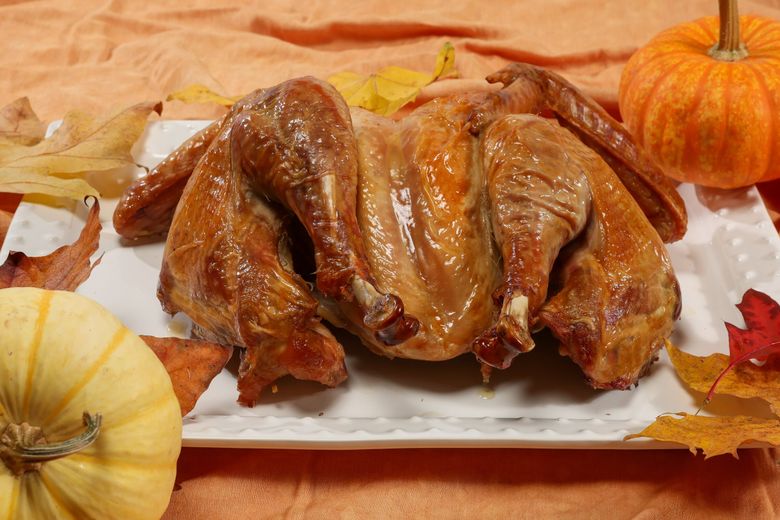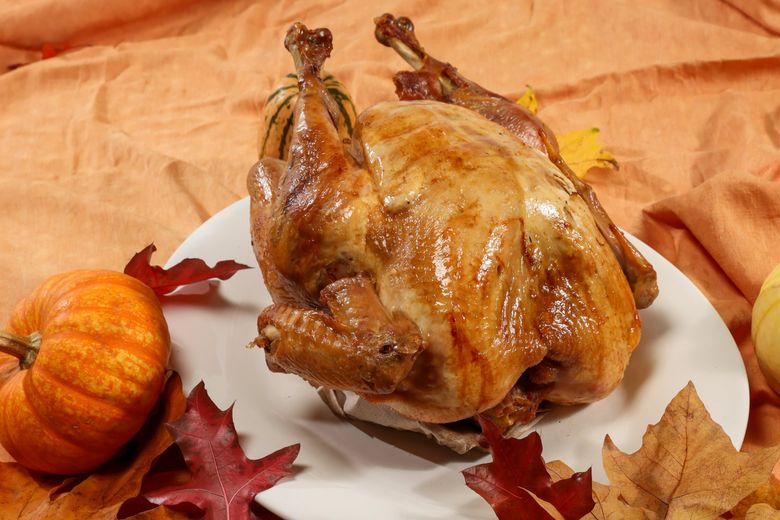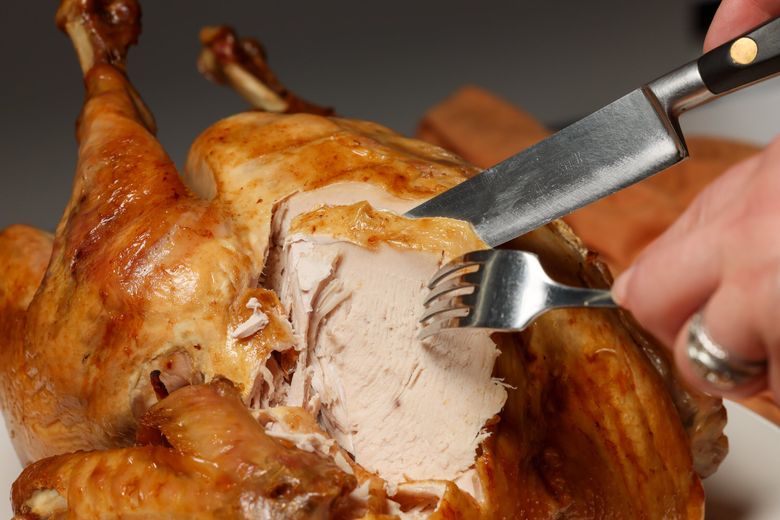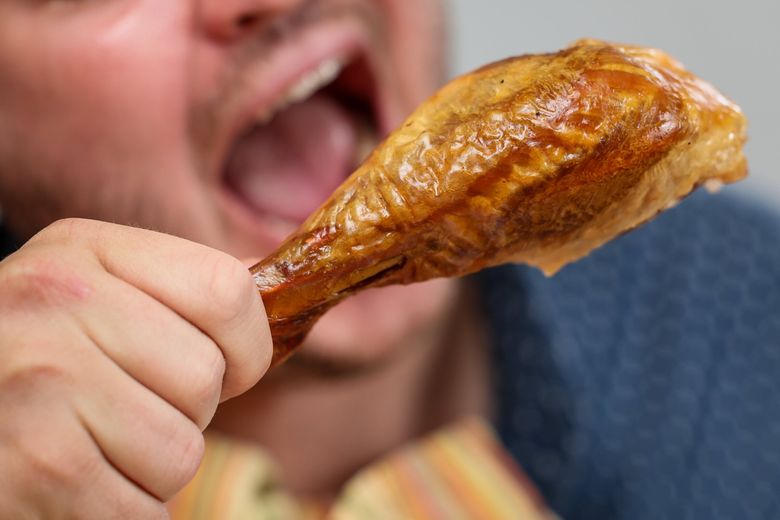Turkey has been an American Thanksgiving staple for centuries. You’d think we’d have perfected the process of roasting this bird by now, but no: Turkey experts answer 100,000 questions every year on the Butterball Turkey Talk-Line. And many think this fowl is foul.
So The Seattle Times food writers set out to find the recipe for the perfect bird. Taking cues from Martha Stewart, “Joy of Cooking” and Tomo chef Brady Williams, we conducted a three-turkey throwdown that began in Jackie Varriano’s kitchen at 4:30 a.m. on a recent Thursday.
After much munching, we agreed on the best bird. Read on for the full taste test, just in time for Turkey Day. Click below to jump to recipes — but first, some notes on methodology and opening comments from our judges.

Jump to recipes
Martha Stewart’s Perfect Roast Turkey | Brady Williams’ Spatchcocked Turkey | “Joy of Cooking” Roast Brined Turkey
Our methods are replicable for any home cook with an oven. Frozen, organic birds from PCC, ranging from 10-12 pounds, were thawed, prepped and cooked in the same oven. After around six hours, they were driven to The Seattle Times office in South Lake Union for beauty shots of their burnished skin before we carved and devoured them.
Talking turkey
Bethany Jean Clement: Some say even bad pizza is good; this is my stance on turkey. While my family Thanksgiving table has hosted the likes of a local heritage-breed bird fed on leftover wine grapes, if a Butterball is happening, I’m there for it. And if Jackie is getting up at 4:30 to test-roast three turkeys, I’m texting her turkey and bulging-bicep emojis and joyously eating cold turkey under conference room lighting at noon.
Tan Vinh: I’m the opposite. I think turkey sucks. Why else would you eat it only once a year? You either get good white or dark meat, never both. One is always over- or undercooked since white meat cooks faster than dark. It’s like the bok choy problem, when the stalk turns tender but the leaves turn soggy. But I’ll try to keep an open mind. No pressure, Jackie.
Jackie Varriano: A good little tiebreaker, I land in the middle. I can take turkey or I can leave it.
Martha Stewart’s Perfect Roast Turkey

This recipe first appeared in a 1995 issue of Stewart’s magazine. It involves soaking a large square of cheesecloth in a bowl full of an entire bottle of dry white wine with three sticks of melted unsalted butter. The skin of the turkey is rubbed with more butter and sprinkled with salt and pepper before being draped with the cheesecloth. You baste every 30 minutes before removing the cheesecloth to cook uncovered to burnish the skin.
BJC: We tasted Martha Stewart’s recipe first, keeping our thoughts to ourselves until this writing — for drama, and also so as to not influence each other’s turkey-opinions.
JV: I had high hopes for this bird as it was the most classically beautiful of the bunch. But, despite basting it with melted butter and wine every half-hour, this bird was so dry. I believe the butter and wine were able to penetrate the breast meat, providing actual flavor to the bird, but the saliva-sucking dryness was so hard to move beyond, especially in the breast. The dark meat and skin from the leg were slightly juicier, but still. So. Dry.
TV: I think the key to a harmonious Thanksgiving party is to find a happy medium, where Team White Meat and Team Dark Meat can coexist. Moist and fatty dark meat on this bird. But no way Team White Meat would be happy with this atrocity. The worst of the three turkeys, the breast meat was flavorless and jerky-like, so dry and hard to take down. If you served this during Thanksgiving, you would not be getting a Christmas card from Team White Meat.
BJC: Agreed. With all gratitude for your poultry heroism, Jackie — and all due respect to Martha Stewart — this bird was my least favorite. As a proponent of X-treme butter usage (and wine!), I expected to love it; what a sad surprise to find the white meat dry to the point of nearly crumbly. Still, I remain thankful, and please pass the gravy!
Brady Williams’ Spatchcocked Turkey

The Seattle Times published this recipe as a part of the 2016 Imperfect Holiday package. The recipe calls for a sugar and salt wet brine or a simplified dry brine option, which we used. Spatchcocking involves using kitchen shears to cut out the backbone of the turkey and flipping it breast side up, pushing on that breastbone hard to crack it, allowing the turkey to lie flat. The bird was rubbed liberally with salt all over and placed uncovered in the fridge for eight hours. This method had the shortest cooking time (90 minutes), with no basting necessary.
JV: This bird was the toughest to make on the front end. It was hard to cut through the backbone and impossible to crack the breastbone down. I had to call for reinforcements.
BJC: When The Seattle Times food staff tested this recipe from then-Canlis–now-Tomo chef Brady Williams back then, I had to lean on the raw turkey with all my might — it didn’t seem like it would work, until: crrrr-ack! Sorry you couldn’t experience this atavistic joy of cooking, Jackie. Maybe try a chicken?!
JV: Well this makes me want to give it another crack. Still, despite lacking the upper arm strength to beat this bird, I loved that it was hands-off once it went in the oven. The finished result was incredibly moist, maybe the juiciest roast turkey I have ever eaten. But I didn’t get much flavor past turkey and it felt almost underseasoned. I wonder if the wet brine, which combined salt and sugar, would’ve yielded a more flavorful bird.
BJC: Spatchcocking supposedly helps white and dark meat cook more evenly — and faster — which played out well here. The white meat stayed fairly moist, though lacking pronounced flavor; the dark thigh meat attained rich succulence and noticeable birdiness in taste. Some consider the drumstick the prime piece, but maybe I’m just not a leg person — here, as with the Martha Stewart turkey, those bites left me underwhelmed.
TV: Agreed, but I thought this was the best of the three white meats in our tasting, though more from the process of elimination than its own merits. This turkey’s breast meat was the only one where I didn’t need gravy. The moist dark meat was underseasoned. But when you use a high-quality bird like Jackie did, even when it’s not dressed up with much, that fatty, pronounced poultry flavor of dark meat shines through. This would hold up well as leftovers.
BJC: Let’s hear it for leftovers! Gravy covers a multitude of sins, especially in a Thanksgiving sandwich: bird, cranberry sauce, dressing (preferably my mom’s oyster version), and gravy on a not-too-crusty baguette or a sturdy-enough roll. I am now very excited for this (and for making turkey stock).
The unanimous winner: “Joy of Cooking” Roast Brined Turkey

This recipe is from the 2006 edition of the cookbook. The brine is simple: 4 cups kosher salt to 2 gallons water. Submerge the turkey and refrigerate for 12-24 hours before rinsing and patting dry. The turkey is stuffed with onion, carrot, celery and thyme, brushed with melted butter and put breast side down onto a V rack set inside a roasting pan. Roast for two hours, basting one to two times with more butter, before flipping breast side up to finish.
BJC: Turkey is tricky. My family wet-brined a bird one Thanksgiving and it just didn’t seem particularly great. Overcooking by committee might have been the issue; a meat thermometer and one vigilant cook are a turkey’s best friends. Jackie has/is both, so it’s telling that the brining method here absolutely nailed it. Winner, winner, turkey dinner!
JV: This bird shocked me in how deep the flavor was. I felt like the brine really penetrated, giving both the breast and the leg meat great, salty flavor. I’ve never flipped a bird halfway through cooking before, but I think it did a great job of promoting an even roast, giving the skin a chance to brown all over. This could be my go-to bird.
TV: We three never agree on anything, but here we are. It’s easily the best of the three birds. The dark meat wasn’t mucked with much, just the taste of fatty meat with salt, so you get a clean, succulent bite of the best part of the turkey. The white meat wasn’t as dry as many I’ve had at Thanksgiving, and certainly salvageable with a thick, umami-rich gravy.
BJC: I thought the breast of this brined bird was juicy, plush and possessed of an ideal salt level. The dark thigh meat rated even juicier, with a complex, layered savor of saline and faint gaminess — delicious. And the drumstick stayed moister than the other birds, with superior flavor.
***
Recipes
“Joy of Cooking” Roast Brined Turkey
Ingredients
- 1 Turkey (10-25 pounds)
- 2 cups table salt or 4 cups kosher salt
- 2 gallons water
- 1 onion, peeled and quartered
- 1 carrot, cut into 1-inch chunks
- 1 small rib celery, cut into 1-inch chunks
- 1 teaspoon dried thyme or 8 sprigs fresh thyme
- 4-6 tablespoons butter, melted plus 2-3 tablespoons butter, melted
Steps
- In a nonreactive container large enough to hold the turkey, combine the salt and water. Stir until the salt dissolves and submerge the turkey in the brine. Refrigerate for 12 to 24 hours. Remove from brine and rinse inside and out. Pat the skin and both cavities dry.
- Position a rack at the lowest level of the oven and preheat to 325 degrees.
- Place the onion, carrot, celery and thyme. Truss if desired. Brush the turkey skin all over with 4-6 tablespoons of melted butter. Place the turkey breast side down on a V rack in a roasting pan. Pour ¾ cup water into the roasting pan.
- Roast for 2 hours if it weighs 18 pounds or less, 2 ½ hours if it weighs between 18-21 pounds, or 3 hours if it weighs more than 21 pounds, basting the back and legs once or twice with the additional melted butter.
- Remove the turkey from the oven. Use paper towels or heat-resistant gloves to turn the turkey breast side up. Return to the oven and roast 30-90 minutes more or until a thermometer reads 170 degrees in the thickest part of the thigh. Let stand for 20-40 minutes before carving.

Brady Williams’ Spatchcocked Turkey
Ingredients
- 1 fresh turkey
- Kosher salt
- Assorted vegetables, such as celery, onion, carrot (optional)
Steps
- Using poultry scissors, with the turkey breast side down, cut along both sides of the backbone to remove. You can save the backbone for stock or for gravy (one of the downsides to this is you can’t stuff the bird).
- Trim away any excess fat along the neck of the bird and discard.
- Flip the bird over, breast side up, and, using the palm of your hand, press down on the sternum of the turkey. You should hear the breast “pop” and the turkey should lie almost perfectly flat.
- Place the turkey on a roasting rack over a sheet pan. If you want, you can chop vegetables, such as onions, celery and carrot, to place under the rack and catch the drippings. Use these vegetables for your gravy or stuffing.
- The night before you plan to roast the turkey, salt it using kosher salt. Make it rain a generous but even amount of salt covering the entire bird — the bird should be well coated but not encrusted.
- Leave the salted turkey in the refrigerator overnight then pull it out a few hours ahead of roasting and place on the kitchen counter to allow it to temper, which will allow a more even cooking.
- Place the turkey, spread out flat, on a roasting rack over a sheet pan. Roast in a 400-degree oven for about 90 minutes — or until the breast reads 140 degrees and the legs read 150 degrees. Remove from the oven and let rest for one hour — the bird should continue to cook and reach an internal temperature of 150 degrees for the breast and 160 degrees for the legs.
- Carve and serve!

Martha Stewart’s Perfect Roast Turkey
Ingredients
- One 20- to 21-pound fresh whole turkey, giblets and neck removed from cavity and reserved
- 1 ½ cups (3 sticks) unsalted butter, melted, plus 4 tablespoons unsalted butter, room temperature
- One 750-milliliter bottle dry white wine
- 2 teaspoons salt
- 2 teaspoons freshly ground black pepper
Steps
- Remove turkey from packaging, pat dry and let stand for 2 hours at room temperature.
- Place rack on lowest level in oven and preheat oven to 450 degrees.
- In a bowl, combine melted butter and white wine. Fold a large piece of cheesecloth into quarters and soak fully in the melted butter and wine mixture.
- Place turkey breast side up on a roasting rack in a heavy metal roasting pan. Fold wing tips under turkey and tie legs together loosely with kitchen string.
- Rub turkey with the softened butter and sprinkle evenly with remaining 1 1/2 teaspoons salt and pepper. Lift cheesecloth out of liquid and squeeze it slightly. Drape the damp cheesecloth evenly over the breast and sides of the turkey.
- Place turkey in oven legs first and cook for 30 minutes.
- Reduce oven to 350 degrees and use a pastry brush to baste cheesecloth and exposed parts of turkey with butter and wine. Continue to cook for 2 1/2 more hours, basting every 30 minutes.
- After this third hour of cooking, carefully remove and discard cheesecloth. Turn roasting pan so that the breast is facing the back of the oven. Baste turkey with pan juices. If there are not enough juices, continue to use butter and wine. Cook 1 more hour, basting after 30 minutes or until the temperature reaches 180 degrees. When fully cooked, transfer turkey to a serving platter, and let rest for about 30 minutes.
https://news.google.com/rss/articles/CBMic2h0dHBzOi8vd3d3LnNlYXR0bGV0aW1lcy5jb20vbGlmZS9mb29kLWRyaW5rL3dlLXRhc3RlLXRlc3RlZC0zLXR1cmtleS1yZWNpcGVzLXRvLW5hbWUtYS10aGFua3NnaXZpbmctZGlubmVyLXdpbm5lci_SAQA?oc=5
2023-11-16 14:00:00Z
CBMic2h0dHBzOi8vd3d3LnNlYXR0bGV0aW1lcy5jb20vbGlmZS9mb29kLWRyaW5rL3dlLXRhc3RlLXRlc3RlZC0zLXR1cmtleS1yZWNpcGVzLXRvLW5hbWUtYS10aGFua3NnaXZpbmctZGlubmVyLXdpbm5lci_SAQA
Bagikan Berita Ini

















The opinions expressed in reader comments are those of the author only and do not reflect the opinions of The Seattle Times.